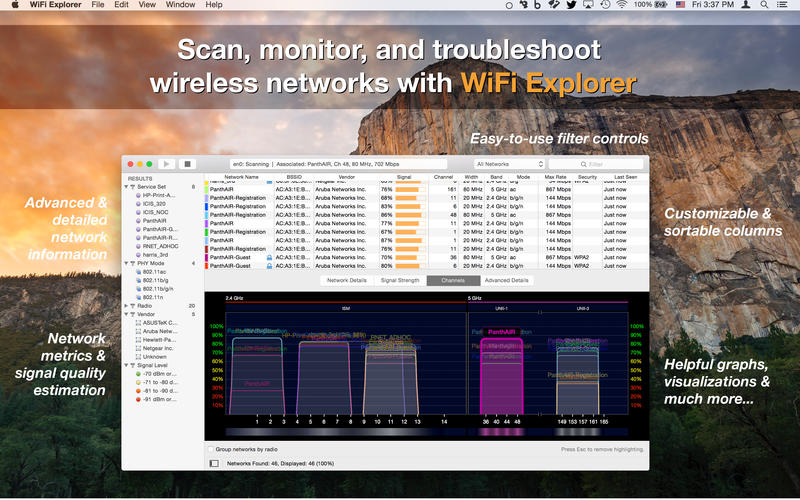

- WIFI EXPLORER NOT SHOWING ALL NETWORKS HOW TO
- WIFI EXPLORER NOT SHOWING ALL NETWORKS PRO
- WIFI EXPLORER NOT SHOWING ALL NETWORKS PASSWORD
- WIFI EXPLORER NOT SHOWING ALL NETWORKS MAC
You’ll need to wait 2-5 minutes for all of the lights to come on and for the signal to begin sending again.
WIFI EXPLORER NOT SHOWING ALL NETWORKS MAC
Step 4: Once your Mac has restarted, turn the router back on. You can get open wireless diagnostics by navigating to Spotlight and then beginning to type “wireless diagnostics”.

Step 1: Find out your router’s IP address.You can manually change the channel though by following a few steps.
WIFI EXPLORER NOT SHOWING ALL NETWORKS HOW TO
How to Fix: Most routers come pre-calibrated to certain frequencies or contain software that helps them pick the best channel. These waves occur at certain frequencies and can be interfered with by other electronic devices such as microwaves or your neighbor’s router. Issue 2: Neighborly router interferenceĬause: As we said earlier, a router sends electronic waves. Can you minimize the amount of distance between you and the router, or otherwise move closer?Īlternatively, consider purchasing an extended if you can’t seem to move the router to a location without too much interference. If your router is already in a fairly clear area, consider where you’re sitting. How to Fix: If your router is currently buried behind a file cabinet, in a closet, or otherwise awkwardly placed you should move it to a more open and central location. Connection Problems Issue 1: Physical router interferenceĬause: A router sends electronic waves, but these can be impeded by thick walls or other large blockages such as a row of metal filing cabinets. Now back to the Wi-Fi not working issues on MacBook Pro, let’s see how to fix each of them. It allows you to browse any corner of the internet without having to worry about your data and privacy. If you must use one of these networks, a proxy or VPN can protect your computer by isolating it from the other connections.Īn excellent example of a secure, user-friendly VPN is ClearVPN 2.
WIFI EXPLORER NOT SHOWING ALL NETWORKS PASSWORD
While it’s tempting to use the free coffee shop Wi-Fi, the lack of a protective password puts your computer at risk because malicious users can use the shared network and attempt to break in. It’s important to connect to secure networks even if it means using a Virtual Private Network (VPN) or proxy. A larger amount of bandwidth means you can request more data at once, which will make your connection seem faster, but it’s not worth paying for if you don’t use your Mac for much beyond Facebook and email. The Internet speed is how fast data can travel on your network, whereas your bandwidth determines the volume of information that can travel at that speed. Whatever your provider advertises is always going to be more than the rates you actually get, but you can always make adjustments on your end to get things running faster.īandwidth is not the same as Internet speed. Your Internet Service Provider (ISP) is what determines your maximum internet speed, but your usage at home is what ultimately determines how well your connection functions. The app offers a range of extensive details about all your Mac networks in the vicinity, including their band, signal quality, range, security status, etc. It’s an awesome app that shows you what’s going on with your network and helps you fix it when needed. You can troubleshoot network connections in the office or at home with WiFi Explorer. It can be a bit intimidating to try and fix without worrying that you’re either doing nothing or making the problem worse.īut no one likes mindlessly refreshing a webpage and hoping the Wi-Fi fixes itself in the meantime, so in this guide, we’ll show you a few ways you can take matters into your own hands to find a solution. We rely on Wi-Fi to do our daily work, and when it inevitably experiences an error of some sort, all you want to do is throw your hands in the air.Īfter all, Wi-Fi frequently seems to be on the more technical end of things, shrouded in mysterious terms like “DNS”, “modem”, and “IP address”. Our smartphones may be equipped with the latest wireless data capabilities, but our MacBooks definitely aren’t.
WIFI EXPLORER NOT SHOWING ALL NETWORKS PRO
As an Amazon Associate, We earn a commission from qualifying purchases at no extra cost to you.Īre you experiencing those Wi-Fi problems with your Mac? For example, your MacBook Pro won’t connect to wifi, connected but no Internet, or the network speed is super slow, etc.


 0 kommentar(er)
0 kommentar(er)
